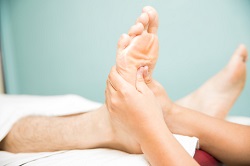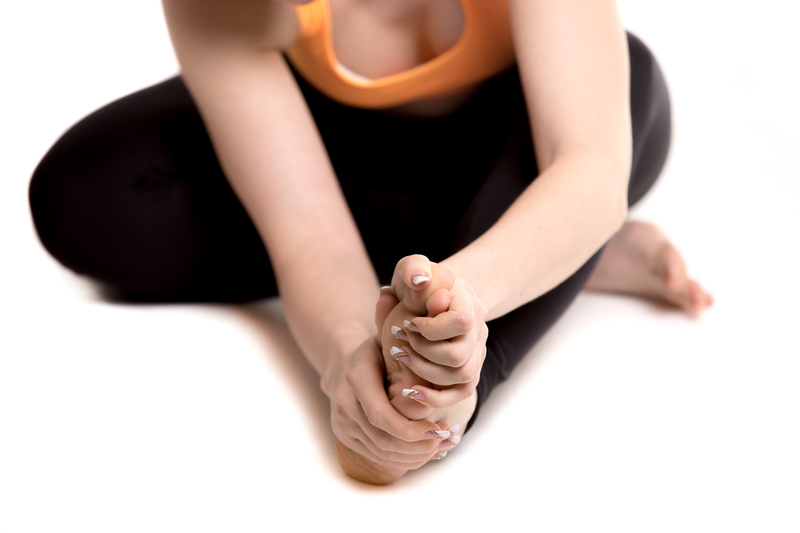Our feet – on which we balance, turn and extend. They also carry us through life when we’re not dancing. The human foot is an astoundingly functional, adaptive mechanism. It’s the fruits of millennia of evolution. Yet some stresses of modern life – insufficiently supportive footwear, long days on our feet, and, yes, rigorous dancing without adequate rest – are beyond the foot’s ability to function and adapt.
It lets us know that through pain. A common instance of this happening is with plantar fasciitis. “Plantar” is the mid-arch of the foot, “fascia” connective tissue, and “itis” refers to inflammation. Taken together, this means inflammation in the tissue of the arch of the foot. Other symptoms which show up with the condition, which are also characteristic of the body’s inflammatory response, include redness and warmth to the touch.
Most problematic, particularly for dancers who have to ask so much of their feet, is the pain. This is most often at the arches, but other areas in the feet can also become sensitive to the touch. Muscles in the area can become tense and strained by the distribution of work and weight (“load”) when mid-foot arches are compromised.
Plantar fasciitis (PF) can also contribute to pain somewhere else, such as at the hips or knees, explains Dr. Johann Howard, physical therapist at the Harkness Center for Dance Injuries in NYC. He estimates that around 10-20 percent of his patients are currently experiencing PF, and about 40 percent have experienced it at some point in the past.
That 20 percent are often coming in for another “primary complaint” or medical issue, and an assessment reveals that they’re also experiencing PF, he explains. Unfortunately, PF can be something that’s not bad enough to call out of rehearsal, school or work for a medical appointment but bad enough to make dancing – and even simply walking – painful.
 The pain can often be bad in the morning but dissipated by later on in the day, after walking around and other activities on the feet, says Howard. We can link activities such as a good amount of jumping to persistent and end-of-day (versus morning) pain. All of that being said, what can we say causes the condition?
The pain can often be bad in the morning but dissipated by later on in the day, after walking around and other activities on the feet, says Howard. We can link activities such as a good amount of jumping to persistent and end-of-day (versus morning) pain. All of that being said, what can we say causes the condition?
Howard breaks it down to two sets of factors: extrinsic and intrinsic. Extrinsic are those from the outer environment, such as temperature, flooring and footwear. The former two can be especially prevalent in contemporary dancers, says Howard, who too often have to dance on non-sprung floors (or other surfaces in site-based work) and chilly rooms.
Ballet dancers, especially those en pointe, tend to have more foot-related issues because of footwear. “A dancer and pointe shoe have to get along like a team,” explains Howard. “It’s so important to get fitted, and re-fitted often, for pointe shoes.” This is because the foot changes over time due to adaptation of being en pointe. Other extrinsic factors include relative stress without rest (overtraining) and a short plié (not bending the knees enough).
Intrinsic factors include a short Achilles tendon and tightness in other foot/lower leg muscles (such as the Flexor Hallucis Longus, which moves the big toe). Excessive pronation (rolling in toward the insteps) or supination (rolling on to the outer edges of the feet) can also contribute to PF, as well as a short plié. As can foot arches on the higher or lower end. Excessive tibial rotation, or turnout, can also contribute to the condition.
Given these known causes, are there ways that we can prevent the condition from happening? We dancers can take certain steps. We can ensure that our footwear is sturdy and supportive, so that when we are not dancing, our feet get a break. Shoes designed with higher arches in cases of high arches, and appropriate arch support in cases of lower arches, can also be helpful in preventing this condition.
Aspects to do with dance technique include making sure our pliés are as full and deep as possible, particularly in landings from jumps – also of course landing smoothly toe-ball-heel. As mentioned, getting fitted and re-fitted into pointe shoes is important for keeping the feet pain-free. A large factor, which Howard stresses, is rest. Overworked feet will let you know, with pain, that they’re overworked.
What if prevention hasn’t happened, and you’re experiencing PF? All of these actions can help ease the condition going forward, and hopefully prevent it in the future. You might come to learn that you are prone to the condition, and then be more proactive with these measures in the future. For what you can do at this point, again, sufficient rest is key to healing.
If you’re in the midst of a performance season, try to be smart about how you can step back and work a little less hard. For example, you can mark whenever possible, try to avoid warming up multiple times before performing (with smart timing), and find places in choreography when you can find subtlety and ease instead of expression and exertion. “It’s a challenge to try to modify movements in preparation for a show when trying to allow an injury to heal, but it’s necessary for healing,” Howard affirms.
Interestingly, some things that are good for health in general can ease the condition (as well as contribute to prevention), such as hydration and a strong core. Thorough and adequate stretching after dancing, which is important for many reasons, can also help make sure no areas in the feet or legs are leading to PF through tightness. Balls such as Foot Rubz (with little points all over) help to work into the arches and bring in blood flow, says Howard.
Physical therapists also utilize a special massage technique called Graston to help bring a lot of blood to the affected region and break up scar tissue. This speeds the healing process. Graston is inspired by a Chinese medicine technique known as guasha, which uses various tools to similarly work into areas that need more blood flow in order to heal.
Howard sees taping a PF-foot as helpful, and not in any way harmful (when done properly). It can stabilize the area and reduce pain, therein making it more manageable. Icing, heat and analgesics can also help make symptoms more manageable – including with pain or sensitivity at other areas of the feet resulting from PF (such as the heels). The only problem is that it doesn’t address the root cause of the problem at hand.
Check in with your technique and lifestyle aspects. Do you pronate or supinate? Do you take a nice deep plié, especially when landing from jumps? Does your footwear fully support your feet, toes to arches to heels? Most of all, Howard says, make sure to give your body appropriate rest. There’s truly no substitute for giving the body the time it needs to restore.
Even if you’ve never suffered from PF, attending to these things can make it more likely that you’ll never have to. If you have in the past, it’ll make it more likely that you won’t have to again. If you’re experiencing it now, you can address the symptoms while also getting at the cause(s) of the condition. You don’t have to dance in pain, with a stage smile while wincing inside. Our feet do a lot for us. Let’s make sure they can keep doing that by caring for them well.
By Kathryn Boland of Dance Informa.















